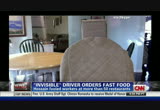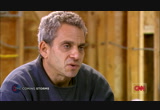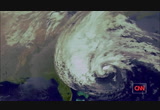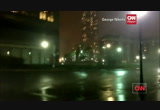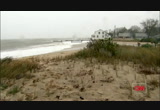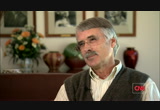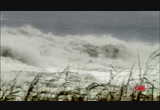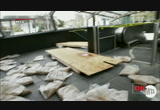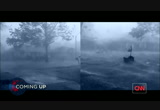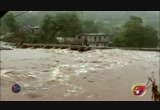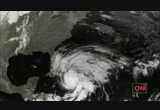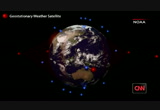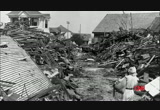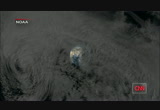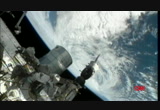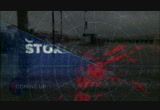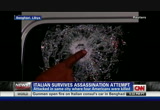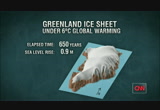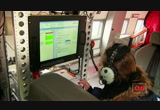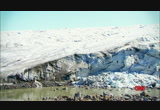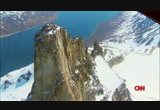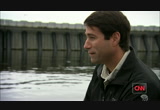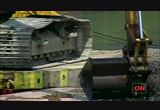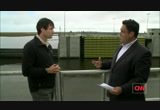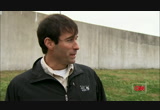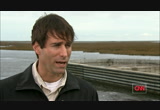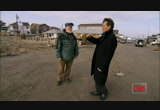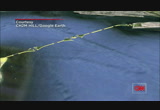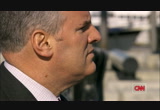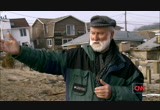tv The Coming Storms CNN January 12, 2013 5:00pm-6:00pm PST
5:00 pm
serious about becoming a magician. originally, raha considered try to get re, actions from motoris on the open road. his costume limited sight so much he figured it might be dangerous. >> basically, the eye hole is right there. a mesh material where you can see through. >> reporter: his hand-made, mostly cardboard costume topped with an actual car seat cover consists of heat and headrest. i could almost sit in you. >> right. >> reporter: he takes his hands off his wheel on the straightaway right before he pulls up to the window. leaving workers looking for the missing driver or calling for an instagram photo. >> instagram. >> reporter: one thing that well behaved car seat absolutely must not do is crack up laughing. >> i was trying hard to keep a straight face. >> reporter: though at the end, he did break character. >> just throw it in here. i'm a ghost. >> oh, well. >> throw it in there? >> yeah, i'm a ghost. just throw it.
5:01 pm
thank you. >> reporter: what, no seat belt? >> no seat belt at all. >> reporter: double take make way. for the triple take. at the takeout window. >> are you serious? >> reporter: jeanne moos, cnn, new york. >> now to "cnn presents." 2012 is now in the record books as the hottest year ever for the continental united states. experts say climate change is a big reason. and last year is just a sign of what's to come. not only higher temperatures but more extreme weather. storms even more damaging. even more dangerous. climate change helped make sandy one of the most devastating storms ever to hit the east coast. and just this week, new york governor andrew cuomo announced proposals designed to prepare for big storms. but what is the rest of the country doing to prepare for the next disaster? we dispatched a team of cnn correspondents across the country and around the world to investigate how bad storms,
5:02 pm
these storms can become and what we can do now to plan when the next big one hits. hurricane sandy threatening to unleash massive damage on the u.s. northeast. >> conditions are deteriorating very rapidly. >> certainly felt more rain, more wind, stronger gusts. >> i've never, in 26 years of forecasting, have seen anything like this. >> they are being called superstorms. fueled by changing climate, higher temperatures, and rising sea levels. >> climate change is real. it's here. it's going to happen again. >> people and cities once safe. now in the eye of the fury. >> i see the weather changing. absolutely. >> is this the era of the superstorm? >> water level is rising substantially. >> and are we ready?
5:03 pm
>> if this wall had been here -- >> for the next one? >> i've been telling everybody, the big flood is coming. we better start building the ark. >> living near the ocean, there's always that chance that the ocean is going to come take away everything that you've got. but never did i imagine that this was going to happen to me and my family and my community. >> even now, given all that has happened to him and his family, it is still hard for nick camerada to understand it all. he has lived here, along the shores of staten island, for two decades, with his wife and four boys. back in 2011, camerada survived
5:04 pm
hurricane irene. so he paid close attention to reports of another potential hurricane headed his way in late october. >> it's been a very fickle storm, but it's going to be sucked in here, into the northeast somewhere. >> we were all hoping that the storm was going to blow more towards the south and not come north. >> reporter: a few miles away, at columbia university, climate scientist adam sobel was keeping an eye on sandy as well. >> at the beginning, look at that, that would be a big deal if that happened. but a week ahead of time, we don't take it that seriously. >> it is still four days away. this could have a bigger impact on new york city, connecticut, long island, new jersey, than irene did last year. >> as sandy moved north, it merged with a winter storm, creating a superstorm, double the size of a normal hurricane. >> the one part storm that was already on land was combining with the hurricane that was offshore. as they combined, it was almost
5:05 pm
one plus one equals two and a half. >> many in sandy's path evacuated. nick camerada did not. >> at about 6:00, the tide should be way out. i walked down the block, and i started seeing water coming on to cedar grove, and i started yelling and banging on doors for everybody to get out of their houses, because this is going to be a storm of disastrous magnitude. >> i was, as a scientist, fascinated, but as a citizen of this city, as time went on, i started to feel more and more actual fear. >> in new york, as the eye of the storm approached, wind gusts reached 75 miles per hour, and the flood waters outside nick camerada's house were rising, fast. >> try to move the car up the street a little bit, i almost
5:06 pm
didn't get back to the house. and i couldn't open the door because there was 3 or 4 feet of water outside the door. when i grabbed the front door of my house, i got zapped by the power from the transformer on the pole. i got paralyzed, knocked to my feet. felt like somebody grabbed my ankles, my body curled up. at that point, i thought i was dead. my wife opened the window and they pulled me through the window and up the stairs, and that's where, you know, we weathered the storm as a family, up on the second floor watching the storm little by little creeping up, you know, to the second story. >> when they were talking about 6 to 12 feet surge, i knew we were in trouble. >> dominic and his wife sheila live two blocks away from camerada. staying with relatives during the storm, they received a troubling phone call. >> he said, "look, something's wrong, the front of your house
5:07 pm
doesn't look like." "what do you mean?" "the whole front is tilted down." >> when the massive superstorm made landfall, sandy and its record 16-foot storm surge washed away neighborhoods. >> whoa! >> flooded subway stations and tunnels, and cut electricity for millions of people, including those on staten island. >> we never had an idea that it would impact so far north into new york city itself. that's what really surprised me. >> and this is the house, this is your house here? >> this is our house. >> what's left of it. >> the house that donny and sheila trayna had lived in for 40 years, sandy destroyed in minutes. >> if we knew the house was going to blow down, we would have took everything out. >> i had a painting that belonged to my grandparents, it was from the
5:08 pm
early 1800s, a watercolor that's been in our family. >> tough, tough. >> it's painful. sorry. >> yeah. >> many weather experts believe sandy is a grim preview of a future with more powerful and more damaging storms fueled by climate change. >> it's not that these storms wouldn't occur and that they wouldn't happen anyway, but there's a little bit of an extra boost. >> dr. kevin trenberth of the national center for atmospheric research says, without question, the warming of the earth's climate will create more extreme weather. >> we know that certainly is the case with hurricanes. the higher sea surface temperature puts more moisture into the atmosphere. that gets sucked up by the storm. there's heavier rainfalls. it boosts the power of that storm a little bit and makes it just a little bit worse than it otherwise would have been.
5:09 pm
>> adding to the destructive future of these superstorms, rising sea levels, also fueled by climate change. >> we have satellites in space that are measuring sea level to millimeter accuracy now. since 1992, sea level has gone up 2 1/4 inches since then. >> we expect more in the next century. if you start with higher water, the storm surge will be added on top of that until we get a higher flood. >> rising seas, heightened storm surge, a terrifying prospect facing millions of people living on the east coast. >> my community, my neighborhoods, my best friends, they were all affected by this in a way they are never going to be able to recover. >> a community overwhelmed, a metropolis brought to a standstill. can our cities withstand a future of bigger, more powerful storms? (phone ringing)
5:10 pm
good afternoon. chase sapphire. (push button tone) this is stacy from springfield. oh whoa. hello? yes. i didn't realize i'd be talking to an actual person. you don't need to press "0," i'm here. reach a person, not a prompt whenever you call chase sapphire. why should saturday night have all the fun? get two times the points on dining in restaurants, with chase sapphire preferred.
5:11 pm
5:12 pm
try capzasin-hp. it penetrates deep to block pain signals for hours of relief. capzasin-hp. take the pain out of arthritis. the electrical systems, the fare collections systems, the lighting systems, the stairways, the ventilation systems, the elevators, the escalators, they are all pretty much ruined from the water damage, from the surge
5:13 pm
damage. >> less than 48 hours after the storm struck, new york city's chief infrastructure officer, frank jesky, took us down into the subway system. >> we'll take a quick look over there. >> to what looked like a scene from a science fiction movie, something beyond imagination. >> believe it or not, these timbers washed in from the ocean or the bay. >> this did right here? >> absolutely. >> so this washed in -- >> all this debris that you see washed in from the tidal surge. >> this station, the end of the line for the city's number one subway train, is called south ferry. three years ago, it was brand new, built at a cost of more than half a billion dollars. now it's in ruins. >> sandy broke records for the biggest waves in new york harbor, for the biggest surge in new york city, and for the lowest pressure ever north of north carolina. what was the impactful part of
5:14 pm
sandy was the surge at 12, 15 feet. that surge had never been seen in new york city before. >> when we were here, the water was just below this mezzanine level. first interview -- >> you can see the rusts on these stair treads. >> -- jesky, this time dressed in a suit and tie, took us back down underground. >> it wasn't a rebuild as some of our stations, this was a brand new tunnel station that was built. they've been taken back to the shops and labs -- >> just rebuilding south ferry station alone can take up to a year or more at a cost he's not even willing to guess about. >> we'll start taking components or pieces of the station down, the finished surfaces, the finished ceiling, the acoustic pieces of it. the signal systems will have to be rebuilt. all the conduits and piping will have to be opened up and drained. >> not to mention a sophisticated and intricate control room. >> this is the train
5:15 pm
dispatchers' office. >> looking now as if a bomb had hit it. >> the dispatchers and supervisors would operate out of this working environment. they had several different workstations where they could see the trains coming in and out of the station. completely destroyed. need to be replaced and rebuilt. >> the force of the water so great, it even destroyed escalators designed to last 40 years. >> the actual force of the water coming down the escalator lifted the landing plates from position. the pit itself still has several feet of water standing in it. these are one of our escalators that's a total loss. >> so this is going to have to come out altogether? >> come out and be replaced. >> the destruction here is just a part, a big part, but just a part of the pounding that the infrastructure system took as a result of superstorm sandy. just imagine, if you will, what happened to the electrical grid on the eastern seaboard. >> the northeast, obviously, took a real beating as a result
5:16 pm
of superstorm sandy. and i think it did reveal a number of weaknesses. among them, questions have come up fairly, i think, whether the utilities really did a good job overall. >> clark gellings knows more about the nation's power grid than practically anyone. he's a fellow at the electric power research institute. were you surprised what a beating the system took? >> i was surprised for a couple of reasons. one, i really wonder about the severity of those winds. my gosh, the trees that were taken down. we're not talking about a limb that should have been cut and it happened to brush across a line. we're talking about trees from across the street coming down and taking a power line down on the other side of the street. >> even more surprising, he says, was just how unprepared some utilities seemed to be. >> some of the utilities involved didn't really have a good what's called "outage management system." there were utilities in the northeast that actually had to
5:17 pm
do this with paper charts on a wall and didn't really have an effective computer system. >> on top of that, gellings says, is the nation's aging electrical infrastructure. >> even major components, take, for example, these large transformers, we call them substation transformers. these are the really big guys. the average age in the united states is 42 years. the design life is 40, so we are running on borrowed time. >> not to mention all those millions of utility poles crisscrossing the country. >> you've got poles out there, wood poles, intended actually to be with us for about 40 years, 50 years. they are out there for 80 years. >> money, he says, will help. some of those overhead wires should be buried underground, but all in all, extreme nature holds all the cards. >> give me all the money in the world, and i'll design a power system that will never fail. the point is, you can't afford to do it. there's just no configuration
5:18 pm
that i can think of that will be absolutely sandy proof. >> it's just so very hard. >> back in staten island, nick camerada says he isn't going anywhere. despite the destruction, despite the heartache, despite the cost in numbers and the cost no one can really measure. >> how are you? >> i think a lot of people emotionally and physically at this point would just be done, and yet you keep going. >> you have to. because i have no place to go. i have my whole life sitting here, and i got to pray that it doesn't happen again. i got to pray that this is a 100 year storm, and in another 100 years, maybe my kids kids ' kids will be dealing with this. >> but will his children even know the storm is coming? some experts say maybe not. >> we would be blinded, and we would not be able to see what's
5:19 pm
going on in the system as well as we can now. if there was a pill to help protect your eye health as you age... would you take it? well, there is. [ male announcer ] it's called ocuvite. a vitamin totally dedicated to your eyes, from the eye care experts at bausch + lomb. as you age, eyes can lose vital nutrients. ocuvite helps replenish key eye nutrients. ocuvite has a unique formula not found in your multivitamin to help protect your eye health. now that's a pill worth taking. [ male announcer ] ocuvite. help protect your eye health. to volunteer to help those in need. when a twinge of back pain surprises him. morning starts in high spirits, but there's a growing pain in his lower back. as lines grow longer, his pain continues to linger. but after a long day of helping others, he gets some helpful advice. just two aleve have the strength to keep back pain away all day. today, jason chose aleve. just two pills for all day pain relief.
5:20 pm
try aleve d for strong, all day long sinus and headache relief. is the same frequent heartburn treatment as prilosec otc. now with a fancy coating that gives you a burst of wildberry flavor. now why make a flavored heartburn pill? because this is america. and we don't just make things you want, we make things you didn't even know you wanted. like a spoon fork. spray cheese. and jeans made out of sweatpants. so grab yourself some new prilosec otc wildberry. [ male announcer ] one pill each morning. 24 hours. zero heartburn. satisfaction guaranteed or your money back. schwab bank was built with all the value and convenience tdd#: 1-800-345-2550 investors want. tdd#: 1-800-345-2550 like no atm fees, worldwide. tdd#: 1-800-345-2550 and no nuisance fees. tdd#: 1-800-345-2550 plus deposit checks with mobile deposit. tdd#: 1-800-345-2550 and manage your cash and investments tdd#: 1-800-345-2550 with schwab's mobile app. tdd#: 1-800-345-2550 no wonder schwab bank has grown to over 70 billion in assets. tdd#: 1-800-345-2550 so if you're looking for a bank that's in your corner, tdd#: 1-800-345-2550
5:21 pm
5:22 pm
for ovnights can feel califolong and lonely.dren, i miss my sister. i miss my old school. i miss my room. i don't want special treatment. i just wanna feel normal. to help, sleep train is collecting pajamas for foster children, big and small. bring your gift to any sleep train, and help make a foster child's night a little cozier. not everyone can be a foster parent, but anyone can help a foster child. hurricane warnings are in effect for jamaica. >> the clock started ticking early. >> this system is huge. >> october 22nd, sandy was born. >> tropical storm sandy, heading
5:23 pm
straight for islands in the caribbean. >> the u.s. at least for now is not in the cone. >> the initial forecast, she might go out to sea, but that changed quickly. >> we were eight days ahead on this storm. we watched this thing on the computers turn left and turn right a couple of times before the one model said this is going to america. >> this could be a big storm as it makes that turn and slams directly into where new york and new jersey come together. >> reporter: seven days before the storm hit, computer predictions, called models, put landfall in new jersey. there was time to get ready, board up, evacuate. >> this morning i formally declared a state of emergency in anticipation of hurricane sandy. >> when the storm hit atlantic city on the 29th, it was just five miles, that's it, just five miles, from where the earliest forecast said it would cross the coastline. >> it's unprecedented. that's the best word i could
5:24 pm
use. there's no way any other storm in recent memory has been forecast that good, for that long. >> this pinpoint accuracy came from powerful super computers. they digest tremendous amounts of data about climate, wind speed, temperature, atmospheric pressure. from buoys in the ocean, planes flying through and around storms, satellites orbiting the earth. in fact, 90% of the data those computer models relied upon came from satellites. >> command control, engineering data. >> right out of here? >> yep, right out of here. >> katherine sullivan is deputy administrator of the national oceanic and atmospheric administration, noaa. the agency is in charge of monitoring and distributing data from two kinds of satellites. one type called gos flies above the equator and provides a close up view of a given area. the other orbit the poles, taking big pictures of the planet's atmosphere.
5:25 pm
>> it's really critical to let us look ahead into the future, from a day to several days, and understand what the state of the atmosphere will be that will affect weather three, four, five days out. >> days of advanced warning we simply didn't have decades ago. >> this town was just completely demolished. >> something the former mayor of galveston texas, lyda ann thomas, knows all too well. she grew up learning about the deadliest hurricane in u.s. history from her grandfather, who barely survived the storm. >> the water rose and met in the middle of the island, so the whole island was under water. >> the entire island of galveston was submerged? >> entire island. all 35 miles of it. >> at least 8,000 people died that day, september 8th, 1900. 145-mile-per-hour winds, no warning, 75 years before satellites and high-tech forecasting. there really wasn't any way to know, was there, for how bad it was going to be. >> they had no idea. overnight they were like a bomb
5:26 pm
had exploded in their city and killed everybody. >> over the years, this storm-battered town was in that cone of uncertainty many times. katrina and rita in 2005. ike in 2008. but the people knew those storms were coming. >> the minute it hit the gulf, we went into high gear, but we were prepared to get into high gear. we were able to do that because of the satellites, because of the communication, and because of the warnings we got. >> we could be without power for as much as seven to ten days. >> reporter: the same warnings that came as superstorm sandy raced up the coastline. >> people across the eastern seaboard, midatlantic, you need to take this very seriously. >> but history might have told a very different story. just a month before sandy, one of those key g.o.e.s. satellites that monitors the atlantic and caribbean where sandy was born went down. >> there was enough uncertainty
5:27 pm
while we're still in hurricane season that we took the precautionary measure to move the other satellite over. >> perhaps, some experts say, a foreshadowing. dr. kevin trenberth of the national center for atmospheric research says noaa got lucky they had a back-up satellite standing by. >> if there's a major failure of the satellites, that would be a major disaster and we would be blinded in many respects. we would not be able to see what's going on in the earth's system as well as we can now. >> there is concern within a few years that safety net may be gone. independent research supports and internal memos show noaa has fallen behind because of budget cuts, complicated organization, and flawed management. i of particular concern, the polar satellites that provide so much of the data on hurricanes and the global big picture. the next generation satellite
5:28 pm
may not be ready by 2016, when the designed life span of the one up there now ends. >> if we didn't have satellites to predict the weather, it would be like you driving at night without headlights. could you do it? maybe. you'd stay on the road mostly. but you wouldn't be a very good driver. >> the effect, startling. researchers found if they didn't have the data from the u.s. polar orbiter, the new forecast would have turned sandy out to sea, potentially leaving people little warning. are we blowing it out of proportion? >> the confidence level, the probability management, we would normally manage our constellation to 70% assurance that this satellite is still working at the time i get a new satellite up there. our projections right now don't give us that confidence interval. it's below that. >> so sullivan's team is trying to speed up satellite
5:29 pm
manufacturing and launch, but at a cost of $1 billion, each one requires five years to build and launch. it's a race against time. >> we're determined to fulfill the mission, working as fast as we can, we're putting the right people into place. i'm trained as an astronaut. i'm not satisfied until we're back home and the mission is a success. >> a crucial mission as climate change threatens to intensify the storms ahead. next, what the polar icecap is telling us about how damaging those storms could be. and later -- >> water level is rising. >> -- can we be ready for the next big one? >> we have been whistling by the graveyard for too long when it comes to dealing with a major weather event. ♪ you know my heart burns for you... ♪ i'm up next, but now i'm singing the heartburn blues. hold on, prilosec isn't for fast relief.
5:30 pm
cue up alka-seltzer. it stops heartburn fast. ♪ oh what a relief it is! hmm, we need a new game. ♪ that'll save the day. ♪ so will bounty select-a-size. it's the smaller powerful sheet. the only one with trap + lock technology. look! one select-a-size sheet of bounty is 50% more absorbent than a full size sheet of the leading ordinary brand.
5:31 pm
use less. with the small but powerful picker upper, bounty select-a-size. use less. with the small but powerful picker upper, capella university understands nurses are dealing with a than wider range of issues. and there are ever-changing regulations. when you see these challenges, do you want to back away or take charge? with a degree in the field of healthcare or nursing from capella university, you'll have the knowledge to advance your career while making a difference in the lives of patients. let's get started at capella.edu.
5:33 pm
here are your headlines this hour. get your flu shot. from the director of the cdc who says it's not too late and it can help the flu epidemic from hitting you. 47 states now reporting what doctors call widespread flu activity an epidemic. companies who make the flu vaccine say there's plent yea vrabel if you want to get a shot. the italy consulate general survived an assassination attempt in benghazi, egypt. just the latest on attacks on foreigners in the city. france's military is carrying out operations in two hot spots in africa.
5:34 pm
rueters is reporting more than 100 people have been killed by french air strikes in northern mali. france has come to the aid of mali's fragile government in its fight against islamic militants. in somalia, two french soldiers killed in an attempt to free a french intelligent agent who may also have died in the raid. syrian act visits say government air forces are back in action and pounding the outskirts of damascus. a week of bad weather grounded most planes. the rebels are claiming victory in the fight for an air base in the north. the fighters say they seized weapons and ammunition after the battle. activists say 108 people were killed today in the civil war. "the coming storms" continues right now. thousands of miles beneath the weather satellites, in one of the most remote places in the world, lie vital clues about the
5:35 pm
planet's future. greenland's arctic ice field is a vast and beautiful piece of nature. it's the second largest ice mass in the world, but it's also very vulnerable to environmental effects like temperature changes. we're taking part in a research mission that's trying to better understand the processes that are at play to more accurately predict how fast the ice here is melting. greenland's ice masses are more than twice the size of texas. this frozen wonderland is constantly in motion. a recent study found this arctic ice shield is losing mass at an alarming rate, close to 300 square kilometers, or about 115 square miles, each year. some fear greenland's ice might disappear all together. if that happened, global sea
5:36 pm
levels would rise seven meters, or about 23 feet. to survey the ice, scientists use one of the most advanced research aircraft in the world, polar 6. its operational base in greenland is north of the arctic circle. a former american military base and a territory's largest airfield. the project's leader and his crew are gearing up for their first survey flight over the massive ice shield. missions like this one can take over six hours and lead halfway across the greenland ice sheet. they need to be planned and executed absolutely precisely to make sure the scientists get exact readouts. we reached the glaciers on the fringes of the inland ice, and the arctic's summer's melt is clearly visible. clear blue melt water ponds dot the landscape, growing as the sun shines on the ice.
5:37 pm
a research camera installed on the plane's belly also records the images as polar 6 advances towards the radar survey area. nasa satellite images recently showed unprecedented surface ice melt here, with about 97% of greenland's ice sheet showing signs of thawing. soon, the glaciers and melt water ponds disappear and there's nothing below but ice. it's almost impossible to distinguish the clouds from the ground. >> we're getting very close to the area of operations right now. it's right in the heart of greenland, and the ice sheet at that area is up to two miles thick. the scientists turn their equipment on and begin the survey. our route takes us to the center of the inland ice.
5:38 pm
he's getting his first readout. tell me what we're seeing here. >> this is surface reflection. >> the arctic is something like an archive of the earth's climate. in its layers, much like in the rings of trees, researchers can find information on temperatures, the amount of precipitation, dust particles, and ash from volcanic eruptions dating back 100,000 years. after several hours in the air, polar 6 makes its way back to the airfield. it will take months to evaluate the data from these flights. >> if we can explain the past, what happens there, then we can use the same programs to run it forward to see what the future will bring us. then we have scenarios where we have changes in temperature in moisture distribution and all these things. >> what these scientists are seeing is that greenland's ice sheet is vanishing quickly. a fact confirmed by the 2012 noaa arctic report card. the report reveals an
5:39 pm
unprecedented loss of summer sea ice and record melting of greenland's ice sheet. to understand why, polar 6 lands at another site six weeks later. they drill deep into thousands of years' worth of ice. soon, the first ice cores emerge. long before the official lab analysis, one scientist can identify some unique patterns even with his naked eye. >> what we can see here definitely are prominent melt layers, so they are so prominent, i have never seen them so far. and steff, who was here 30 years ago, he doesn't remember any melt layers at that time. we had one or two centimeter thick melt layers, and they indicate that we had extremely warm summers here. >> reporter: the ice cores are essentially compressed snow that
5:40 pm
fell here over tens of thousands of years. each layer holds a record of the climate in a certain era. the further down they drill, the further they go back in time. one of those taking part in the drilling mission is trevor popp, a climatologist from the university in copenhagen. >> these ice cores in greenland tell us basically the past climate, what the ice can record. and this is stuff like temperature, the amount of precipitation, the seasonal precipitation, dust impurities in the atmosphere, and importantly changes from year to ye that you might see. >> by studying how quickly, how often, and why temperatures change in the past, scientists can better understand how our climate is evolving today. for now, one thing seems clear, melting ice and rising sea levels increase the potential of a damaging storm surge, and that can be catastrophic. especially when it comes to a storm like hurricane katrina. what did the death and devastation teach us, and are we
5:42 pm
with two times the points on dining in restaurants, you may find yourself asking why not, a lot. chase sapphire preferred. there's more to enjoy. let's say you want to get ahead how do you get from here... to here? at university of phoenix we're moving career planning forward so you can start figuring that out sooner. ln fact, by thinking about where want your education to lead, while you're still in school, you might find the best route... leads somewhere you weren't even looking. let's get to work. and you see the woman you fell in love with. she's everything to you. but your erectile dysfunction - that could be a question of blood flow. cialis tadalafil for daily use helps you be ready anytime the moment's right. you can be more confident
5:43 pm
in your ability to be ready. and the same cialis is the only daily ed tablet approved to treat ed and symptoms of bph, like needing to go frequently or urgently. tell your doctor about all your medical conditions and medications, and ask if your heart is healthy enough for sexual activity. do not take cialis if you take nitrates for chest pain, as this may cause an unsafe drop in blood pressure. do not drink alcohol in excess with cialis. side effects may include headache, upset stomach, delayed backache or muscle ache. to avoid long-term injury, seek immediate medical help for an erection lasting more than four hours. if you have any sudden decrease or loss in hearing or vision, or if you have any allergic reactions such as rash, hives, swelling of the lips, tongue or throat, or difficulty breathing or swallowing, stop taking cialis and get medical help right away. ask your doctor about cialis for daily use and a 30-tablet free trial. i've got two tickets to paradise!l set? pack your bags, we'll leave tonight. uhh, it's next month, actually... eddie continues singing: to tickets to... paradiiiiiise!
5:44 pm
no four. remember? whoooa whooaa whooo! you know ronny, folks who save hundreds of dollars by switching to geico sure are happy. and how happy are they jimmy? happier than eddie money running a travel agency. get happy. get geico. fifteen minutes could save you fifteen percent or more. we don't let frequent heartburn come between us and what we love. so if you're one of them people who gets heartburn and then treats day after day... block the acid with prilosec otc and don't get heartburn in the first place! [ male announcer ] one pill each morning. 24 hours. zero heartburn. august 2005. hurricane katrina smashes into the gulf coast.
5:45 pm
1,800 dead, $100 billion in damage, the most catastrophic disaster in recent u.s. history. caused by a storm surge that could have been stopped. >> after the storm, i came by to patrol this area in a boat, and the water was actually over that gutter line. >> new orleans police officer steve fox lost everything when the 17th street canal collapsed. >> water as far as the eye can see. neighbors are gone, everything destroyed. you couldn't believe what you were seeing. >> garrett graves couldn't believe it either. the force of these walls collapsing with the wall of water that came down, literally, just blew everything out. it was just a game changer. >> graves is the assistant to the new hurricane
5:46 pm
protection plan. >> never forget those images. it's one of the reasons so many people here have such resolve to make sure that we never allow anything like that to happen here again. >> katrina proved new orleans was a disaster waiting to happen. the storm revealed an inadequate and outdated system of levies and flood walls that failed and caused the massive flooding. >> i think that some of the major flaws in the system were a lack of recognition for the actual strength or power or storm surge associated with a hurricane. in some areas not anticipating that water would truly be up against the top of a levy or the top of a flood wall and putting that much pressure upon the system. >> after katrina, new orleans, and the u.s. congress said never again. spending $14.5 billion in mostly federal funds to build a fortress around the city. among its most powerful new weapons, the largest storm surge
5:47 pm
barrier in the world. where we are now, is this where the majority of the flooding came through in hurricane katrina? >> well over 20 feet of water came surging through this area where we are right now. it just funneled in and rushed into the city of new orleans. >> this massive wall is drilled 190 feet into the earth and towering 26 feet above the water. how much stronger are these walls that have been built around here than what was in place before? >> absolutely incomparable. you have about 50 times more steel in this than the eiffel tower. >> where this barrier begins, 150 miles of stronger levies and higher flood walls connect, forming a circle around the city and keeping the deadly storm surge out, but this illusion brings its own problems. essentially, what has been built around the city of new orleans is a wall, it's almost like a giant bathtub. >> it is, it is. which causes additional problems, because when you
5:48 pm
create a bowl, then when you have rainfall from hurricanes or other events, you then potentially fill up that bowl and flood homes a different way. every time you build these walls, you have to think about how you're going to evacuate the water or pump the water out of the bowl. >> to empty the bowl, another epic solution, new orleans built the world's largest water pumping station. >> it can pump about 30,000 cubic feet of water per second, which is just extraordinary. so that pumping station can fill an olympic-sized swimming pool in about four and a half seconds. >> and there are 76 more pump stations like this, giving new orleans what might be the best hurricane protection system in the country. the people who might move into this neighborhood now, who don't trust this wall, what would you tell them? >> i would tell that that this is the safest this area has ever been. you'll never have storm surge against the other side of this wall again. >> that promise is what
5:49 pm
convinced steve fox to return to his lakeview neighborhood and rebuild. >> born and raised, i'll die here. it's my community. i took a stand. love new orleans, and i knew i was coming back. >> but fox knows the storms will come back, too, and in case the walls and levies fail again, he built a last line of defense, a hurricane-resistant home. >> i can tell you one thing, if the contractor that built my house built those levee, that canal would have never broke. >> his new house and his city faced their first test last august, when hurricane isaac brought a storm surge close to the size of katrina's. grave said the damage could have been catastrophic, but the new infrastructure kept fox's home and the city dry. >> when you look at the likelihood of hurricanes hitting this area, no question in my mind that this system's going to pay off multiple times. >> what do you think the difference would have been had all of this been in place before hurricane katrina? >> i think that the day after hurricane katrina, we would have been going back to work and that
5:50 pm
we would have been sleeping in our own beds, in our own homes, and we wouldn't have been looking for hundreds of body bags and caskets and planning 1,800 funerals. >> reporter: it took 1,800 lives and $100 billion to change new orleans. what will it take to change the rest of the country? people have doubts about taking aspirin for pain. but they haven't experienced extra strength bayer advanced aspirin. in fact, in a recent survey, 95% of people who tried it agreed that it relieved their headache fast. visit fastreliefchallenge.com today for a special trial offer. but with advair, i'm breathing better. so now i can be in the scene. advair is clinically proven to help significantly improve lung function. unlike most copd medications, advair contains both an anti-inflammatory
5:51 pm
and a long-acting bronchodilator working together to help improve your lung function all day. advair won't replace fast-acting inhalers for sudden symptoms and should not be used more than twice a day. people with copd taking advair may have a higher chance of pneumonia. advair may increase your risk of osteoporosis and some eye problems. tell your doctor if you have a heart condition or high blood pressure before taking advair. if you're still having difficulty breathing, ask your doctor if including advair could help improve your lung function. get your first full prescription free and save on refills at advaircopd.com. so we created the extraordinarily comfortable sleep number experience. a collection of innovations designed around a bed with dualair technology that allows you to adjust to the support your body needs - each of your bodies. our sleep professionals will help you find your sleep number setting. exclusively at a sleep number store.
5:52 pm
sleep number. comfort individualized. queen mattresses start at just $699. and now save 50% on the closeout of our silver limited edition bed. ends sunday. your mouth has sipped, snacked, ...yellowed... lived, loved, ...yellowed... chatted, chewed, ...yellowed. and over all those years, your teeth...have yellowed. fact is, if you're not whitening, you're yellowing. crest 3d white whitestrips remove over ten years of stains by going below the enamel surface. and, they whiten 25 times better than a leading whitening toothpaste. crest whitestrips. life opens up when you do.
5:54 pm
when superstorm sandy hit breezy point, new york, ocean waves crashed on to city streets and rocked houses off their foundations. the only option residents had was to head for higher ground. >> they were sitting ducks. there was nothing they could do except run. >> how high was the water right here? >> the water would be probably six feet above our heads. >> six feet?
5:55 pm
>> above our heads. 12 feet, say. >> malcolm bowman is an expert on the many dangers of a storm surge hitting new york. surveying the damage, he reveals that everything we see left by superstorm sandy is a bitter contradiction, apparently inevitable, yet tragically preventible. how do you stop something like that? >> you can't stop it except if you're going to build some kind of regional protection system for metro new york. >> bowman leads the storm surge research group at long island's stony brook university. the group promotes a plan called the outer harbor gateway, an elaborate system of barriers and causeways that would virtually flood proof much of metro new york, all for billions less than the damage caused by sandy. >> the barrier itself across the five-mile opening to new york
5:56 pm
harbor would cost about $13 billion. in addition, the sand berms on both sides, on the sandy hook side and the far rockaways side, would need to be built up for another $5 billion. so for $20 billion, you could have complete protection for new york harbor, including the three major airports. >> a $20 billion project that would take decades to complete, compared to the $30-plus billion needed right now to fix new york's storm damage. it's hardly a radical idea or a new one. similar barriers already exist in stamford, connecticut, and providence, rhode island. massive barriers are also in operation in europe. >> people ask me if the dutch can do it, if the russians can do it, why can't we? >> bowman warned for the need of storm barriers years ago, writing in "the new york times" in 2005 after katrina. he tried again in 2008 on a climate change panel convened by mayor bloomberg, but no barriers
5:57 pm
were built. >> if barriers and sand dunes had been properly built in the last eight years, none of this would have happened. i've been trying to get this message that this catastrophe was going to happen, and it may happen sooner or later. i feel my middle name is noah, and i've been telling everybody the big flood is coming. we better start building the ark. >> but new york isn't the only u.s. city lagging behind in the battle against rising sea levels, and not every problem can be solved by building walls. >> so here in boston you have, you know, the problem that so many east coast cities are facing. we built the city on the water. >> steven flynn is a leading advocate for investing big in projects that make the u.s. more resilient to disaster. >> on a scale of one to ten, how
5:58 pm
prepared are we right now in the northeastern u.s.? >> on a scale of one to ten, we're roughly in a three range. >> three? >> we have been whistling by the graveyard for too long when it comes to dealing with a major weather event, especially in the northeast. >> one place to start, he says, could be power grids and transits systems, critical, yet storm vulnerable infrastructure that gives coastal cities life. >> americans basically have got themselves into thinking that bad events are things that somebody else is supposed to prevent from happening. >> prevent and pay for. take, for example, the choices now facing the people of breezy point. did these people have any protection at all? >> they have no protection at all. what we're looking for is the ocean, you can't see it, it's behind these grass beds, but it's about a quarter of a mile
5:59 pm
from us, but it's flat. it's as flat as a football field. >> malcolm bowman says the construction of sand dunes 30 feet high would have been enough to keep breezy point dry, a project that could be a tough sell outside the flood zone. who is going to pay for this? >> well, people that live here are paying for it in terms of human misery and the tragedy, but if we talk about paying for it in terms of rebuilding and the dollars, where are the dollars going to come from, and are people in the midwest going to want to pay for protecting these privileged few people who are lucky enough to live on the ocean's edge? i don't think so. >> experts, including bowman, say there will be more storms after sandy, each one, he believes, bringing the nation closer to a conclusion he has already reached. >> we have to start planning. it's no longer every person for themselves. there's too much at risk. we have to do it.
96 Views
Uploaded by TV Archive on

 Live Music Archive
Live Music Archive Librivox Free Audio
Librivox Free Audio Metropolitan Museum
Metropolitan Museum Cleveland Museum of Art
Cleveland Museum of Art Internet Arcade
Internet Arcade Console Living Room
Console Living Room Books to Borrow
Books to Borrow Open Library
Open Library TV News
TV News Understanding 9/11
Understanding 9/11
